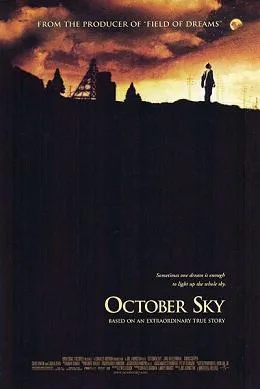Historical accuracy of October Sky

Historical accuracy of October Sky

Characters
Homer Hickam
Based directly on Homer "Sonny" Hickam Jr., the author of the memoir. The film accurately portrays his inspiration from Sputnik and his passion for rocketry, though some plot details are altered.
John Hickam
Based on Homer Hickam Sr. The film emphasizes his opposition to Homer's dreams for dramatic conflict; while tension existed, Homer Sr. was ultimately supportive. His first name was changed for the film.
Elsie Hickam
Accurately reflects the real Elsie Hickam's encouragement of Homer's ambitions beyond coal mining and her role as a mediator.
Miss Freida Riley
Based on the real teacher who significantly supported and inspired the Rocket Boys. Her positive influence and belief in the students are accurately portrayed.
Quentin Wilson
A real member of the Rocket Boys, accurately depicted as the group's theorist and expert in calculations.
Roy Lee Cooke
A real member of the Rocket Boys and close friend of Homer, accurately depicted as part of the core group.
More characters
Sherman O'Dell
Represents the real Sherman Siers, another member. The film condensed the six real Rocket Boys into four main characters.
Jim Hickam
Based on the real Jim Hickam, accurately shown pursuing a football scholarship as his path out of Coalwood.
Ike Bykovsky
Based on a real machinist who helped the boys. His support is accurate, but his death in the mine being a result of punishment for helping them is likely dramatic license.
Principal Turner
Represents the school administration, initially skeptical but later supportive of the boys' project.
Leon Bolden
Represents the miners and the union presence in Coalwood, reflecting community dynamics. The union was supportive of the boys in reality.
Dorothy Platt
Represents Homer's high school romantic interests, based on real people but likely condensed/dramatized for the film.
Story
Sputnik launch inspires Homer (Oct 1957)
The sighting of Sputnik 1 was the pivotal event that sparked Homer Hickam's passion for rocketry, as detailed in his memoir.
Forming the Rocket Boys club (BCMA)
Hickam and his friends did form the Big Creek Missile Agency (BCMA) to design and launch rockets. The film depicts four members representing the real six.
Father's initial opposition to rocketry
While Homer Sr. initially wanted Homer to work in the mines, the film likely exaggerates the extent and duration of his opposition for dramatic effect.
Miss Riley's crucial support and guidance
Teacher Freida Riley was a vital source of encouragement, providing resources and pushing the boys towards the science fair.
Community support (machinists, townspeople)
The boys received significant help and eventual support from various members of the Coalwood community.
Moving launch site to "Cape Coalwood"
Safety concerns forced the boys to establish a remote launch site on an old slack dump several miles out of town.
Accusation of starting a wildfire
The boys were accused of starting a fire. The film dramatizes Homer proving their innocence with trajectory calculations; in reality, authorities quickly realized their rockets weren't capable of reaching the site.
Winning the National Science Fair
The Rocket Boys won the gold and silver medals in propulsion at the 1960 National Science Fair, a major achievement that opened doors to college.
Homer temporarily works in the mine
The film shows Homer dropping out of school to work in the mine after his father's injury. Hickam did work in the mine one summer between school years, but not under these circumstances.
Ike Bykovsky's death in mine accident
The real Ike Bykovsky did tragically die in a mine accident, a poignant event reflecting the dangers of mining life.
Stealing railroad parts for rockets
The film shows the boys stealing crucial parts. Hickam stated they attempted to take a pipe once but were unsuccessful and nearly caught/killed.
Homer's father attends final launch
The emotional climax where Homer Sr. attends the final launch and presses the firing button is based on a real event described in the memoir.
Homer meeting Wernher von Braun
The film implies they met at the National Science Fair. Hickam has stated they were at the same event but narrowly missed meeting each other.
Calculation of lost rocket's trajectory
While the specific plot point of proving innocence this way was dramatized, the boys did learn advanced mathematics and physics to calculate trajectories for their rockets.
Setting
Coalwood, WV in the late 1950s
Though filmed in Tennessee, extensive set construction and design accurately recreated the look, feel, and atmosphere of a 1950s West Virginia coal company town.
Coal company town environment
Effectively portrays the pervasive influence of the coal company on all aspects of life – work, housing, social structure, and limited opportunities.
Coal mine exterior and interior
Realistic recreation of the mine tipple and the cramped, dangerous conditions inside the mine shafts, based on research and Hickam's experiences.
Post-Sputnik era / Space Race context
Accurately captures the national excitement, anxiety, and renewed focus on science education triggered by the Soviet launch of Sputnik in 1957.
High school setting
Represents a typical rural American high school of the period, including classrooms, social cliques, and the emphasis placed on athletics (football).
Appalachian culture
Attempts to convey the regional culture and dialect, though primarily through the lens of the main narrative about escaping the expected path.
Costumes, cars, props
Clothing styles, vehicles, household items, and technology (like TVs) generally align well with the late 1950s period, despite minor noted anachronisms (e.g., flag).
Rocket building/launching locations
Shows the progression from backyard experiments to the established, remote "Cape Coalwood" launch site, reflecting the boys' journey and increasing sophistication.
